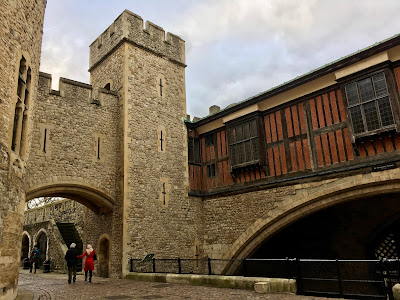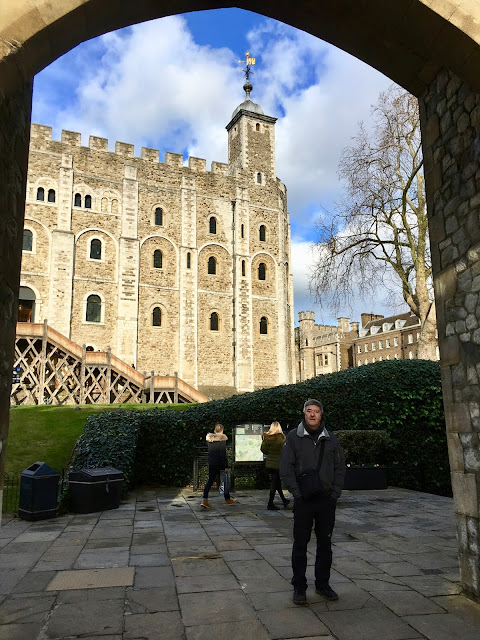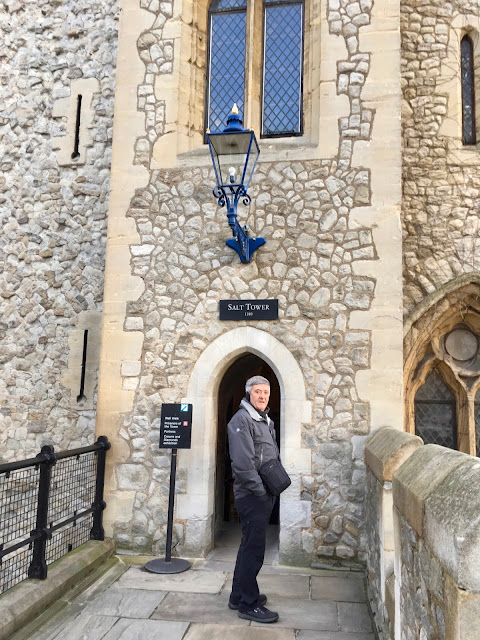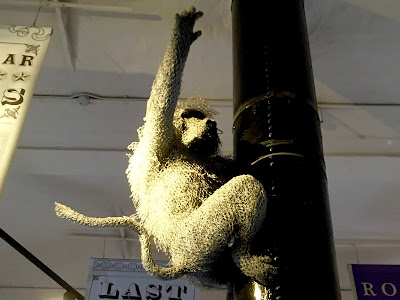In the late 1970s when John and I first visited England we toured the Tower of London. We've returned to the city many times since and until this year never considered a repeat performance. John, however, suggested we do it this time around and I am ever so glad he did. Like many things (us, wine, to name a few) the tower exhibits have improved (and expanded) with age.
We arrived just in time to take a guided tour. Our particular Beefeater was quite eloquent - doing his best to terrorize children and keep disorderly adults in line - all the while providing an interesting and thorough history of the tower.
One of our first stops was just outside the entrance to the Bloody Tower beside Traitor's Gate.
Here we heard about Mary Queen of Scots, the two young princes, Guy Fawkes as well as a number of Henry VIII's wives who spent time here before they died. The last prisoner to be held in the tower before his execution was Josef Jakobs, a German spy, executed on August 15, 1941.
Traitor's Gate was built in the late 1270s by Edward I to provide a water gate entrance to the Tower.
Rooms in the Tower of London were not one's typical bare-bones keep. Prisoners of noble birth were allowed furnishings that would have been considered a luxury for the majority of citizens.
Our next stop was the chapel of the Church of St. Peter ad Vincula, but first we had to walk through the stone archway, up a flight of stairs, past the Tower Green to our left and the White Tower to our right. With so much to see our heads were spinning like tops.
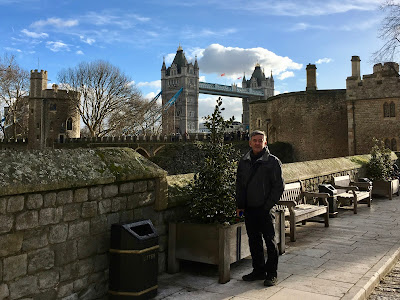 |
| Walkway from the Bloody Tower to Chapel |
 |
| Tower Green |
 |
| White Tower |
 |
| Church of St. Peter ad Vincula on the right |
If one stands in just the right spot the Gherkin can be seen hiding behind the tree in the middle of the photo below.
The Beefeater guide made sure to hurry us along, ordering everyone to gather round as he explained the significance of all that surrounded us. I took a photo of another group later in the day as I did not dare step out of line as it could easily resulted in an "off with her head" command to his colleagues!
 |
| Church of St. Peter ad Vincula (St. Peter in Chains) |
Photos were not allowed inside the chapel, but thanks to Google I found two that show its grandeur.
Our guided tour ended here and it's amazing how quickly 60-minutes flies by when it's both informative and entertaining. We really enjoyed it.
Next stop was the Crown Jewels in the building across the way to the Church. Two guards were on duty.
Photography is not allowed inside the vault so it's Google to the rescue once again. The vault rooms have been totally upgraded since our first visit. In fact, neither John nor I recognized much except the crowns themselves! One upgrade was a welcome feature - the walking escalator (below) - that insured no stragglers or jewel-hogs would slow the procession of visitors.
Photography is not allowed inside the vault so it's Google to the rescue once again. The vault rooms have been totally upgraded since our first visit. In fact, neither John nor I recognized much except the crowns themselves! One upgrade was a welcome feature - the walking escalator (below) - that insured no stragglers or jewel-hogs would slow the procession of visitors.
As we'd just watched a BBC special on the Queen's coronation the crown jewels were particularly interesting. In the hour-long show Elizabeth II talks about the crown jewels as well as their history with so many previous monarchs. Here's a short excerpt:
Next we toured the White Tour (built 1078). There are 205 steps to the top, but it's not all in one go and well worth the effort as there are exhibit rooms on all three floors.
The view from the top of the outside wooden staircase (shown above) offered a spectacular view of London in all its glory.
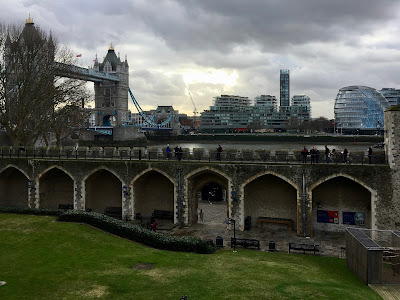 |
| Tower Bridge on the left, City Hall on the far right |
 |
The Shard on the far right, while the rectangular cages visible at the bottom are the home of the Tower's ravens. |
 |
| View overlooking the Tower Green residences |
The Queen's House was built around 1530 by Henry VIII. He probably built it for his second wife, Anne Boylen who also stayed here before her execution.
 |
| Close-up view (note the Guard standing on guard outside the entrance) |
Inside the White Tower on the first floor is the Line of Kings Horse and Armour Exhibit. Although I'm not a fan of either I found the display breathtaking. The attention to detail on both the wooden king's and horse's plus their armour is in combination a work of art.
 |
| King Henry VIII's armour |
 |
| Detailing on the skirt of Henry VIII's armour |
The Line of Kings exhibit dates back to the 17th century and is one of the earliest tower museum exhibits. It was installed for King Charles II by the Royal Armouries to promote the restored monarchy after its dissolution in 1649.
Moving upward to the second floor we found the original stone walls and sheer size of the tower's interior fascinating.
Through the doorway to the far right (above) one enters the St. John the Evangelist Chapel.
Originally used as a storeroom it has now been restored to its former glory.
A narrow alleyway leads to another large exhibit room with even more armour and weaponry.
The Lumley Horseman (below) is the oldest known English equestrian statue. Commissioned by John, Lord Lumley, c.1534-1609, to decorate his family home Lumley Castle in County Durham, it is the precursor to the wooden horses and figures created for the Tower of London one hundred years later.
 |
| Lumley Horseman |
The final exhibition room includes the infamous chopping block where so many lost their heads, a few other rather horrid torture devices (below left) and a time honoured display of military weapons recreated into stunning displays and sculptures.
The latest creation is this dragon made from numerous weapons and associated items such as chainmail. Even the Royal Mint that was housed in the Tower until 1810 in included.
 |
| Homage to the Royal Mint as shown in the "belly" of the dragon |
So much of this visit felt new and neither John nor I remember being allowed to walk around the perimeter of the tower walls. This time, however, it was encouraged and we took full advantage.
One of the towers housed the Royal Beasts from the 1200s to 1835. This included polar bear who was chained, but allowed to swim and catch his lunch in the Thames, lions, tigers, monkeys, elephants, zebras, alligators, bears and kangaroos.
After a number of human casualties in the 19th century the animals were moved to what is now the London Zoo. Today the only animals at the tower are made of chicken wire and created by artist Kendra Haste.
The views from the tower walk are spectacular.
 |
| Facing the White Tower |
 |
| Turning 180 degrees and facing the Thames |
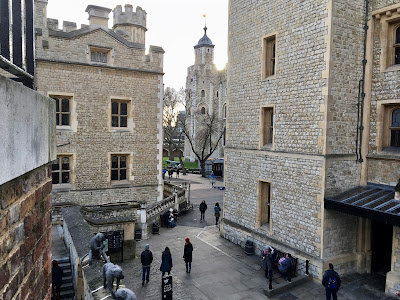 |
| Taken from the north east tower |
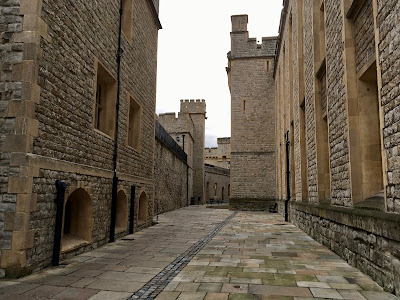 |
North west Alleyway below the wall walkway and behind the Crown Jewels vault. |
After three or so hours of exploring the Tower we strolled east along the Thames River Walk past St. Katherine's Dock/Marina.
Our destination? A pub we quite like, the Town of Ramsgate Pub. Established in 1545, it's been a Wapping landmark for almost 500 years.
 |
| Steak & Ale Pie - £11.75 |
 |
| Mini Fish & Chips £13.95 |
On the return walk to the Tower of London tube station the city lights were just beginning to glow.
As we walked along the western edge of the Tower of London we couldn't help but capture it one more time. All in all a wonderful day in an incredible, vibrant city.
* * *





